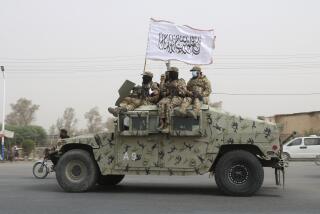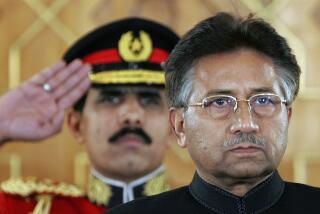Victory Could Hinge On Islamabad’s Spy Agency
QUETTA, Pakistan — Behind a dusty gray wall in the military district here works an organization with secret knowledge that could spell success or doom for U.S. military operations against Osama bin Laden and his ally, the Taliban.
Mysterious and powerful, Pakistan’s Inter-Services Intelligence agency has been called a state within a state. It has been the largely hidden hand in Afghan politics for more than two decades, working with the CIA to defeat occupying Soviet forces and then, on its own, funneling arms and advice to help the Taliban movement become Afghanistan’s master in 1996.
Back then, the Taliban victory was viewed as the agency’s crowning success and a breakthrough for Pakistani interests. But under U.S. pressure after the Sept. 11 attacks, Pakistan concluded that the Taliban was too hot to be tolerated, and the agency was told to turn against its former friends.
“We now see in retrospect the tragic folly of entrusting our Afghan policy to the ISI--an institution full of intelligence but devoid of wisdom,” noted M. P. Bhandara, a former member of the National Assembly, writing in the daily newspaper Dawn.
With the U.S. desperate to woo at least some prominent defectors from the Taliban and to learn the whereabouts of Bin Laden and other leaders of his Al Qaeda terrorism network, the importance of the agency is difficult to overstate. Few believe that the Taliban will be able to hold out if the agency tells everything it knows and shares access to its agents.
“I am of the opinion that not a needle in Afghanistan is secret from the ISI,” said Mehmood Achakzai, a leading politician in Quetta from the Pushtun ethnic group, which fills the Taliban ranks. “The Taliban cannot survive for three days without our patronage.”
Some Observers See a Reluctant Ally
But strong doubts about the agency’s loyalties linger in some quarters.
Some Pakistanis and Western diplomats view the agency as at best a reluctant ally in the war on terrorism. Some accuse it of playing a double game, pretending to help while quietly allowing weapons to flow into Afghanistan since Sept. 11, encouraging Pakistani religious parties to rally support for the Taliban, and turning a blind eye to many volunteers from Pakistan crossing the Afghan border to fight against U.S. forces.
Pakistani President Pervez Musharraf insists that the agency can be trusted to follow his government’s directives.
“Everything happens with the knowledge of the chief executive,” he told reporters Friday. “It is a misperception that ISI is operating on its own.”
Lower-level agents seem to agree that the agency has little scope for freelancing, especially during a time of national crisis.
“Look, we have been fudging a lot in the past, but this one we cannot fudge,” said a recently retired agency operative.
Indeed, according to sources in Pakistan’s Afghan refugee community, the agency has made efforts to enlist new clients inside Afghanistan to help overthrow the Taliban, as shown by a meeting arranged in the Pakistani city of Peshawar last week of former moujahedeen willing to become Taliban opponents.
And on the record, U.S. officials have said they are satisfied with the assistance they have been getting from Pakistan.
When the Taliban rose to power, it was commonly believed that the ragtag army of Islamic fundamentalists had become Pakistan’s proxy in the region. One of the Taliban’s first major engagements, in 1994, was to rescue a Pakistani government-sponsored aid convoy blocked by warlords outside the Afghan city of Kandahar. Whether the Islamic movement was the stepchild of the ISI or the ISI simply adopted a new indigenous force with obvious potential, it is clear that the Taliban presented many advantages for Pakistan at the time.
Riding on the unifying banner of strict adherence to Sunni Islam, the faith of most Afghans and Pakistanis, the Taliban could rise above the internecine warfare that had ripped Afghanistan apart and restore stability. Then Pakistan would be able to open more direct trade routes to Central Asia.
The Taliban also would give Pakistan a friendly, ethnic-Pushtun-led regime to the west while it faced its traditional enemy, India, to the east. The Pushtun ethnic group is the largest in Afghanistan, and Pakistan viewed it as the most stable choice to govern.
Bin Laden Connection Meant Training Sites
The Taliban’s alliance with Bin Laden also gave the ISI access to Al Qaeda training camps, according to Pakistani intelligence officials. The agency sent Muslim militants to train in Afghanistan for guerrilla actions in Kashmir, a region claimed by both India and Pakistan.
Then-director of the agency, Lt. Gen. Mahmud Ahmed, was in the U.S. on Sept. 11. According to Pakistani sources, he was given an ultimatum by Deputy Secretary of State Richard L. Armitage that Pakistan had to assist in the war against terror.
From the first, the U.S. demands included full sharing of ISI intelligence about the Taliban and Bin Laden.
Within days, Mahmud was sent by Musharraf on the first of two missions to Afghanistan. The aim, as defined by the president, was to make it clear to Taliban leaders that they would face U.S. attack unless they turned over Bin Laden.
Mahmud came back empty-handed. But the choice of messenger was significant: Taliban officials heard that they were facing elimination from the head of the agency that had been their staunchest supporter in the war against the erstwhile government of Afghanistan, now the opposition Northern Alliance.
It was a clear message that the Taliban could no longer depend on the agency’s support. But when did the ISI actually stop helping the regime?
One Pakistan-based diplomat said it was widely accepted that a Taliban supply line carrying arms and other war gear ran from Pakistan into Afghanistan, even after United Nations sanctions against the Taliban were imposed in January for the regime’s failure to heed a deadline to surrender Bin Laden and close terrorist camps. The supply line continued, the diplomat said, for weeks after Sept. 11.
This source, whose duties included tracking arms shipments, said he had received a report that six trucks loaded with arms and equipment crossed this fall from the Pakistani town of Miram Shah into Afghanistan’s Paktia province. The arms reportedly were bound for the Taliban provincial governor, Jalaluddin Haqqani, a warlord who operates from the Afghan border town of Khowst.
More recently, Haqqani is believed to have met in Islamabad, the Pakistani capital, with ISI operatives, who may have been wooing him to oppose the Taliban.
Though the diplomatic source admitted that he had no proof, he expressed little surprise at reports that the arms shipments continued after Sept. 11. He believes Pakistani intelligence has elements “that do their own thing. . . . Down at the operational level, guys are making policy.”
But, as in similar instances, there was not enough proof to confront the Pakistani government, the diplomat said.
“We had nothing concrete in this regard, so we don’t know what they were supplying,” said the official. “It’s frustrating. We would dearly have thrown it in their face because we thought it was going on.”
Proof of the supply route was never found, in part because the issue remained too low a political priority, this source said. With little funding to back up the Security Council resolution passed in January, the U.N. designated only 16 monitors for Pakistan’s 1,500-mile frontier with Afghanistan. Pro-Taliban leaders in Pakistan also threatened to kill monitors who entered remote frontier areas to carry out their work.
In the southwestern border town of Chaman as well, Pushtun residents assert that the established flow of ammunition and arms continued well after Sept. 11.
According to Rahim Hamkar, a tribal leader in the town, shipments to the Taliban were common knowledge and continued until U.S. forces began bombing Afghanistan on Oct. 7.
“The movement was carried out in the middle of the night. The whole area was cordoned off by the Pakistani army, and no one was allowed into there,” said Hamkar, whose town is at the main border crossing between Quetta and Kandahar.
He asserted that ammunition and some arms for the Taliban, disguised as humanitarian aid, were delivered almost nightly by convoys of tarpaulin-covered Mercedes-Benz trucks from Sept. 11 until Oct. 4 or 5. Other shipments traveled by rail from the ISI compound in Quetta--the rail tracks go right into the headquarters complex--to Chaman, where they were loaded onto trucks, he said.
The tribal leader said that he did not see the shipments himself but that they had been reported to him.
“We in the Pushtun system share each and every thing in the mosques, in shops and in the bazaars,” he said. “I have lived on the border for 43 years, and I watch and I know everything that is going on.”
Involvement in Arms Shipments Murky
If such shipments were taking place, it is unclear whether top officials of the ISI knew of them or whether they were being carried out by rogue elements of the organization, whose size is estimated at between 15,000 and 40,000 people. It also cannot be said whether the support would have been provided for political reasons, profit or both.
Academics at Islamabad’s Institute of Strategic Studies assert that Pakistan had grown disillusioned with the Taliban well before Sept. 11. Fazal-ur-Rahman, a senior research fellow, traces the frustration to soon after the movement took power in 1996.
“Pakistan expected that after consolidating rule, they would start easing up and giving more freedom,” he said. “That did not happen.”
The unmistakable signal that the ISI’s policy had reversed came on Oct. 7, the day the U.S. bombing campaign began. Musharraf suddenly replaced Mahmud as director general of the agency with Lt. Gen. Ehsanul Haq, who reportedly is more willing to carry out an anti-Taliban policy.
The shake-up at the top was accompanied by a purge of the middle ranks of the agency, to remove officers deemed too close to the Taliban, the former operative said.
In Quetta, journalists said Mahmud had met secretly the week before his dismissal with the Taliban ambassador to Islamabad, Abdul Salam Zaeef, and with Fazlur Rehman, the leader of the pro-Taliban Jamiat-ul-Ulema-e-Islam party, who is now under house arrest and charged with sedition.
At least one published report in Pakistan after Mahmud’s dismissal hinted that he might have advocated pro-Taliban street protests to discourage the U.S. from seeking extensive Pakistani assistance in the anti-terrorism campaign.
A report Friday in the News, a national Pakistani daily, quoted unnamed security officials as asserting that the ISI is not in a good position to help the U.S. mount any operations against the Taliban.
According to sources described as former and current security officers, the agency was caught “totally unprepared” to work against the Taliban regime because of the suddenness of the policy shift. The report said all agency officials inside Afghanistan were known to the Taliban and were hastily withdrawn after Pakistan agreed to side with the United States.
“The flow of information from inside Afghanistan has been slowed to a trickle,” Pakistani Foreign Minister Abdus Sattar told The Times on Thursday.
But that view probably would be disputed by Achakzai, the Pushtun nationalist political leader in Quetta, who said the connections between the agency and the Taliban should not be underestimated.
“Whatever the forces of the holy war were doing was in communication with the ISI,” he said. “They [the agents] know each and every barrel of petrol in that country. Afghanistan was made by them. Afghanistan was their house.”
He said the U.S. should say to the ISI today: “This [Taliban] carpet was spread by you. Now fold it back up.”
*
Times staff writer Rone Tempest in Islamabad contributed to this report.
More to Read
Sign up for Essential California
The most important California stories and recommendations in your inbox every morning.
You may occasionally receive promotional content from the Los Angeles Times.










